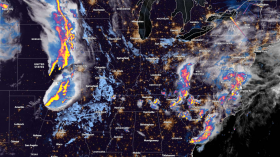Researchers from University of Utah have used a new device to capture the beauty and complexity of snowflakes in midair.
"Until our device, there was no good instrument for automatically photographing the shapes and sizes of snowflakes in free-fall. We are photographing these snowflakes completely untouched by any device, as they exist naturally in the air," said Tim Garrett, an associate professor of atmospheric sciences.
The device has been developed partly by funds from NASA and the U.S. Army and includes three industrial scale high-speed cameras; two 1.2 megapixel cameras and one 5 megapixel camera. Also, the instrument has two motion sensors to detect the snowflakes, said Cale Fallgatter, who formed the Fallgatter Technologies that made the device called MASC, for Multi-Angle Snowflake Camera.
The new camera set-up only takes images in black and white as they give a clearer picture. The exposure time of the camera is about -40,000th of a second, which helps it capture a snowflake as it falls without blurring the image.
MASC has been capturing snowflakes from the past two years. Researchers say that studying snowflakes helps forecast weather and improve microwave communication.
Current weather forecast systems depend on calculating the shape and size of snowflakes and according to Garrette, errors in predicting the shape and size of the snowflakes can lead to errors in predicting amount and location of snowfall.
Today, researchers use data from studies conducted on snowflakes done in the 1970s in the Pacific Northwest's Cascade Range, where snowflakes were collected on plastic wraps and photographed and then melted to find their mass.
"These early researchers got only a few hundred images over two years because they had to collect each snowflake individually by hand. Our snowflake camera can automatically collect thousands of snowflake photographs in a single night." Garrett said in a news release.
© 2024 NatureWorldNews.com All rights reserved. Do not reproduce without permission.





